2016 CHEVROLET CORVETTE engine overheat
[x] Cancel search: engine overheatPage 236 of 351
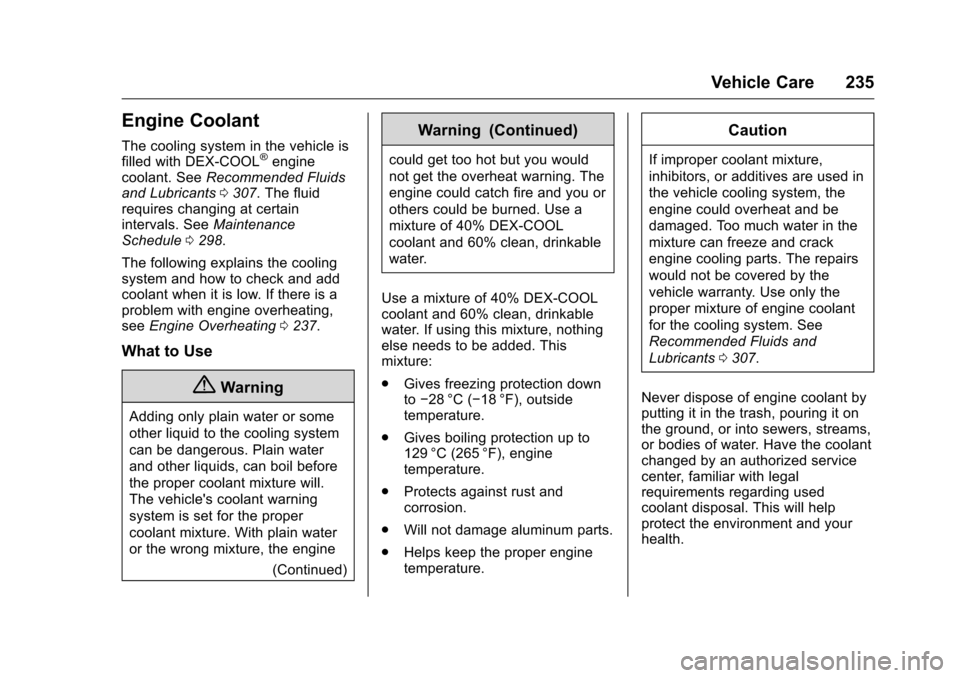
Chevrolet Corvette Owner Manual (GMNA-Localizing-U.S./Canada/Mexico-
9085364) - 2016 - crc - 9/15/15
Vehicle Care 235
Engine Coolant
The cooling system in the vehicle is
filled with DEX-COOL®engine
coolant. See Recommended Fluids
and Lubricants 0307. The fluid
requires changing at certain
intervals. See Maintenance
Schedule 0298.
The following explains the cooling
system and how to check and add
coolant when it is low. If there is a
problem with engine overheating,
see Engine Overheating 0237.
What to Use
{Warning
Adding only plain water or some
other liquid to the cooling system
can be dangerous. Plain water
and other liquids, can boil before
the proper coolant mixture will.
The vehicle's coolant warning
system is set for the proper
coolant mixture. With plain water
or the wrong mixture, the engine
(Continued)
Warning (Continued)
could get too hot but you would
not get the overheat warning. The
engine could catch fire and you or
others could be burned. Use a
mixture of 40% DEX-COOL
coolant and 60% clean, drinkable
water.
Use a mixture of 40% DEX-COOL
coolant and 60% clean, drinkable
water. If using this mixture, nothing
else needs to be added. This
mixture:
. Gives freezing protection down
to−28 °C (−18 °F), outside
temperature.
. Gives boiling protection up to
129 °C (265 °F), engine
temperature.
. Protects against rust and
corrosion.
. Will not damage aluminum parts.
. Helps keep the proper engine
temperature.
Caution
If improper coolant mixture,
inhibitors, or additives are used in
the vehicle cooling system, the
engine could overheat and be
damaged. Too much water in the
mixture can freeze and crack
engine cooling parts. The repairs
would not be covered by the
vehicle warranty. Use only the
proper mixture of engine coolant
for the cooling system. See
Recommended Fluids and
Lubricants 0307.
Never dispose of engine coolant by
putting it in the trash, pouring it on
the ground, or into sewers, streams,
or bodies of water. Have the coolant
changed by an authorized service
center, familiar with legal
requirements regarding used
coolant disposal. This will help
protect the environment and your
health.
Page 237 of 351
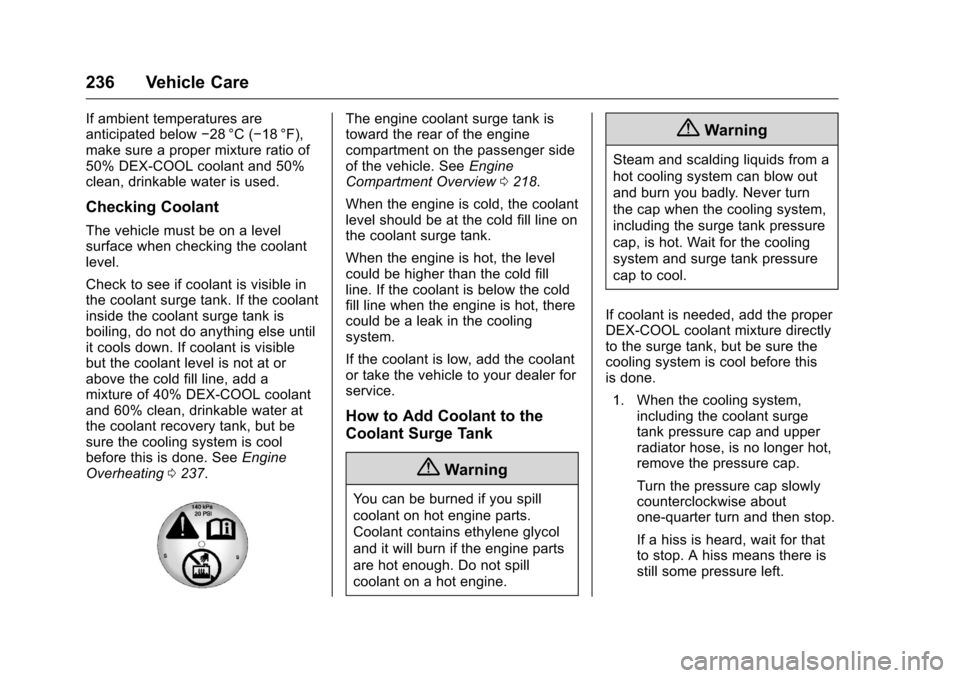
Chevrolet Corvette Owner Manual (GMNA-Localizing-U.S./Canada/Mexico-
9085364) - 2016 - crc - 9/15/15
236 Vehicle Care
If ambient temperatures are
anticipated below−28 °C (−18 °F),
make sure a proper mixture ratio of
50% DEX-COOL coolant and 50%
clean, drinkable water is used.
Checking Coolant
The vehicle must be on a level
surface when checking the coolant
level.
Check to see if coolant is visible in
the coolant surge tank. If the coolant
inside the coolant surge tank is
boiling, do not do anything else until
it cools down. If coolant is visible
but the coolant level is not at or
above the cold fill line, add a
mixture of 40% DEX-COOL coolant
and 60% clean, drinkable water at
the coolant recovery tank, but be
sure the cooling system is cool
before this is done. See Engine
Overheating 0237.
The engine coolant surge tank is
toward the rear of the engine
compartment on the passenger side
of the vehicle. See Engine
Compartment Overview 0218.
When the engine is cold, the coolant
level should be at the cold fill line on
the coolant surge tank.
When the engine is hot, the level
could be higher than the cold fill
line. If the coolant is below the cold
fill line when the engine is hot, there
could be a leak in the cooling
system.
If the coolant is low, add the coolant
or take the vehicle to your dealer for
service.
How to Add Coolant to the
Coolant Surge Tank
{Warning
You can be burned if you spill
coolant on hot engine parts.
Coolant contains ethylene glycol
and it will burn if the engine parts
are hot enough. Do not spill
coolant on a hot engine.
{Warning
Steam and scalding liquids from a
hot cooling system can blow out
and burn you badly. Never turn
the cap when the cooling system,
including the surge tank pressure
cap, is hot. Wait for the cooling
system and surge tank pressure
cap to cool.
If coolant is needed, add the proper
DEX-COOL coolant mixture directly
to the surge tank, but be sure the
cooling system is cool before this
is done. 1. When the cooling system, including the coolant surge
tank pressure cap and upper
radiator hose, is no longer hot,
remove the pressure cap.
Turn the pressure cap slowly
counterclockwise about
one-quarter turn and then stop.
If a hiss is heard, wait for that
to stop. A hiss means there is
still some pressure left.
Page 238 of 351

Chevrolet Corvette Owner Manual (GMNA-Localizing-U.S./Canada/Mexico-
9085364) - 2016 - crc - 9/15/15
Vehicle Care 237
2. Keep turning the pressure capslowly, and remove it.
3. Fill the coolant surge tank with the proper DEX-COOL coolant
mixture until the level inside
stabilizes at the cold fill line on
the front of the surge tank.
4. With the coolant surge tank pressure cap off, start the
engine and let it run until the
upper radiator hose can be felt
getting hot. Any time during
this procedure, watch out for
the engine cooling fan.
By this time, the coolant level
inside the coolant surge tank
may be lower. If the level is
lower, add more of the proper
mixture to the coolant surge
tank until the level stabilizes at
the cold fill line on the coolant
surge tank.
5. Replace the pressure cap tightly.
Check the level in the surge
tank when the system has
cooled down. If the coolant is
not at the proper level, repeat Steps 1−4, then reinstall the
pressure cap. If the coolant is
not at the proper level when
the system cools down again,
see your dealer.
Caution
If the pressure cap is not tightly
installed, coolant loss and
possible engine damage may
occur. Be sure the cap is properly
and tightly secured.
Engine Overheating
The vehicle has several indicators
to warn of engine overheating.
There is an engine coolant
temperature gauge on the
instrument cluster. See
Engine
Coolant Temperature Gauge 0103.
The vehicle may also display a
message on the Driver Information
Center (DIC). See Engine Cooling
System Messages 0123. If the decision is made not to lift the
hood but to get service help right
away, see
Roadside Assistance
Program 0319.
If the decision is made to lift the
hood, make sure the vehicle is
parked on a level surface.
Then check to see if the engine
cooling fan is running. If the engine
is overheating, the fan should be
running. If it is not, do not continue
to run the engine and have the
vehicle serviced.
Caution
Running the engine without
coolant may cause damage or a
fire. Vehicle damage would not be
covered by the vehicle warranty.
Page 239 of 351

Chevrolet Corvette Owner Manual (GMNA-Localizing-U.S./Canada/Mexico-
9085364) - 2016 - crc - 9/15/15
238 Vehicle Care
If Steam Is Coming from the
Engine
{Warning
Steam from an overheated engine
can burn you badly, even if you
just open the hood. Stay away
from the engine if you see or hear
steam coming from it. Just turn it
off and get everyone away from
the vehicle until it cools down.
Wait until there is no sign of
steam or coolant before you open
the hood.
If you keep driving when the
engine is overheated, the liquids
in it can catch fire. You or others
could be badly burned. Stop the
engine if it overheats, and get out
of the vehicle until the engine
is cool.
If No Steam Is Coming from
the Engine
If an engine overheat warning is
displayed but no steam can be seen
or heard, the problem may not betoo serious. Sometimes the engine
can get a little too hot when the
vehicle:
.
Climbs a long hill on a hot day.
. Stops after high-speed driving.
. Idles for long periods in traffic.
If the overheat warning is displayed
with no sign of steam: 1. Turn the air conditioning off.
2. Turn the heater on to the highest temperature and to the
highest fan speed. Open the
windows as necessary.
3. When it is safe to do so, pull off the road, shift to P (Park) or
N (Neutral) and let the
engine idle.
If the temperature overheat gauge is
no longer in the shaded area or an
overheat warning no longer
displays, the vehicle can be driven.
Continue to drive the vehicle slowly
for about 10 minutes. Keep a safe
vehicle distance from the vehicle in
front. If the warning does not come back on, continue to drive normally
and have the cooling system
checked for proper fill and function.
If the warning continues, pull over,
stop, and park the vehicle
right away.
If there is no sign of steam, idle the
engine for three minutes while
parked. If the warning is still
displayed, turn off the engine until it
cools down.
Washer Fluid
What to Use
When the vehicle needs windshield
washer fluid, be sure to read the
manufacturer instructions before
use. If the vehicle will be operating
in an area where the temperature
may fall below freezing, use a fluid
that has sufficient protection against
freezing.
Page 248 of 351
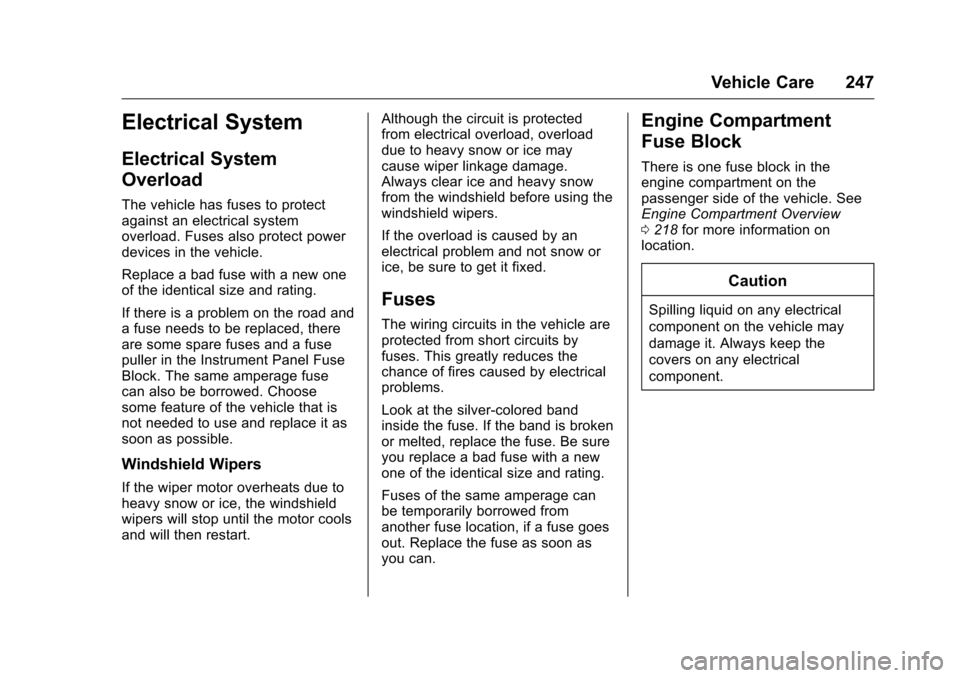
Chevrolet Corvette Owner Manual (GMNA-Localizing-U.S./Canada/Mexico-
9085364) - 2016 - crc - 9/15/15
Vehicle Care 247
Electrical System
Electrical System
Overload
The vehicle has fuses to protect
against an electrical system
overload. Fuses also protect power
devices in the vehicle.
Replace a bad fuse with a new one
of the identical size and rating.
If there is a problem on the road and
a fuse needs to be replaced, there
are some spare fuses and a fuse
puller in the Instrument Panel Fuse
Block. The same amperage fuse
can also be borrowed. Choose
some feature of the vehicle that is
not needed to use and replace it as
soon as possible.
Windshield Wipers
If the wiper motor overheats due to
heavy snow or ice, the windshield
wipers will stop until the motor cools
and will then restart.Although the circuit is protected
from electrical overload, overload
due to heavy snow or ice may
cause wiper linkage damage.
Always clear ice and heavy snow
from the windshield before using the
windshield wipers.
If the overload is caused by an
electrical problem and not snow or
ice, be sure to get it fixed.
Fuses
The wiring circuits in the vehicle are
protected from short circuits by
fuses. This greatly reduces the
chance of fires caused by electrical
problems.
Look at the silver-colored band
inside the fuse. If the band is broken
or melted, replace the fuse. Be sure
you replace a bad fuse with a new
one of the identical size and rating.
Fuses of the same amperage can
be temporarily borrowed from
another fuse location, if a fuse goes
out. Replace the fuse as soon as
you can.
Engine Compartment
Fuse Block
There is one fuse block in the
engine compartment on the
passenger side of the vehicle. See
Engine Compartment Overview
0
218 for more information on
location.
Caution
Spilling liquid on any electrical
component on the vehicle may
damage it. Always keep the
covers on any electrical
component.
Page 344 of 351
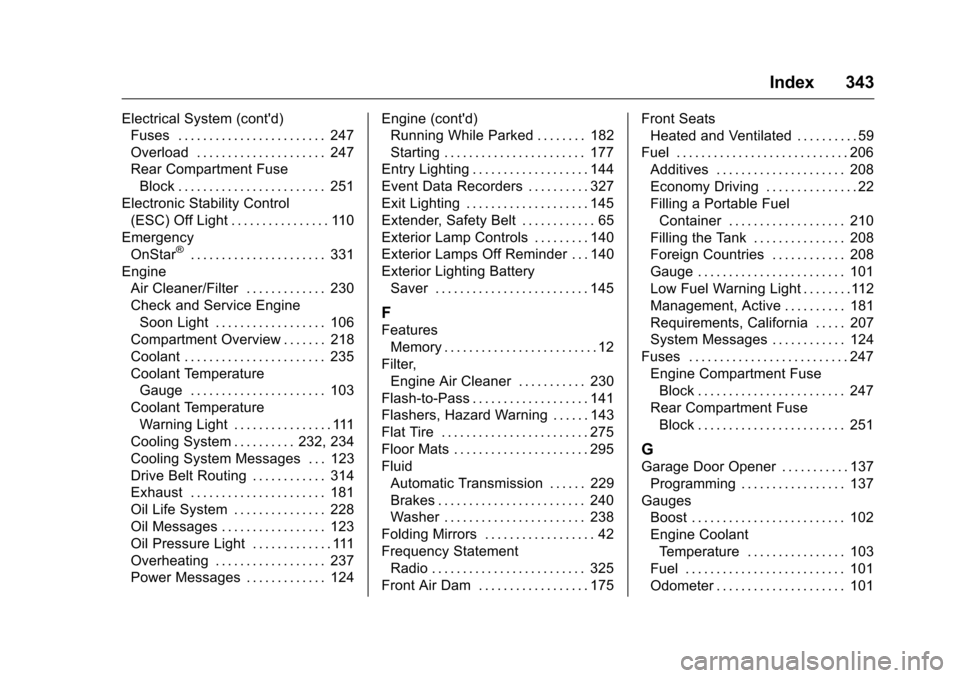
Chevrolet Corvette Owner Manual (GMNA-Localizing-U.S./Canada/Mexico-
9085364) - 2016 - crc - 9/15/15
Index 343
Electrical System (cont'd)Fuses . . . . . . . . . . . . . . . . . . . . . . . . 247
Overload . . . . . . . . . . . . . . . . . . . . . 247
Rear Compartment Fuse
Block . . . . . . . . . . . . . . . . . . . . . . . . 251
Electronic Stability Control (ESC) Off Light . . . . . . . . . . . . . . . . 110
Emergency OnStar
®. . . . . . . . . . . . . . . . . . . . . . 331
Engine Air Cleaner/Filter . . . . . . . . . . . . . 230
Check and Service EngineSoon Light . . . . . . . . . . . . . . . . . . 106
Compartment Overview . . . . . . . 218
Coolant . . . . . . . . . . . . . . . . . . . . . . . 235
Coolant Temperature
Gauge . . . . . . . . . . . . . . . . . . . . . . 103
Coolant Temperature
Warning Light . . . . . . . . . . . . . . . . 111
Cooling System . . . . . . . . . . 232, 234
Cooling System Messages . . . 123
Drive Belt Routing . . . . . . . . . . . . 314
Exhaust . . . . . . . . . . . . . . . . . . . . . . 181
Oil Life System . . . . . . . . . . . . . . . 228
Oil Messages . . . . . . . . . . . . . . . . . 123
Oil Pressure Light . . . . . . . . . . . . . 111
Overheating . . . . . . . . . . . . . . . . . . 237
Power Messages . . . . . . . . . . . . . 124 Engine (cont'd)
Running While Parked . . . . . . . . 182
Starting . . . . . . . . . . . . . . . . . . . . . . . 177
Entry Lighting . . . . . . . . . . . . . . . . . . . 144
Event Data Recorders . . . . . . . . . . 327
Exit Lighting . . . . . . . . . . . . . . . . . . . . 145
Extender, Safety Belt . . . . . . . . . . . . 65
Exterior Lamp Controls . . . . . . . . . 140
Exterior Lamps Off Reminder . . . 140
Exterior Lighting Battery
Saver . . . . . . . . . . . . . . . . . . . . . . . . . 145
F
FeaturesMemory . . . . . . . . . . . . . . . . . . . . . . . . . 12
Filter, Engine Air Cleaner . . . . . . . . . . . 230
Flash-to-Pass . . . . . . . . . . . . . . . . . . . 141
Flashers, Hazard Warning . . . . . . 143
Flat Tire . . . . . . . . . . . . . . . . . . . . . . . . 275
Floor Mats . . . . . . . . . . . . . . . . . . . . . . 295
Fluid Automatic Transmission . . . . . . 229
Brakes . . . . . . . . . . . . . . . . . . . . . . . . 240
Washer . . . . . . . . . . . . . . . . . . . . . . . 238
Folding Mirrors . . . . . . . . . . . . . . . . . . 42
Frequency Statement Radio . . . . . . . . . . . . . . . . . . . . . . . . . 325
Front Air Dam . . . . . . . . . . . . . . . . . . 175 Front Seats
Heated and Ventilated . . . . . . . . . . 59
Fuel . . . . . . . . . . . . . . . . . . . . . . . . . . . . 206 Additives . . . . . . . . . . . . . . . . . . . . . 208
Economy Driving . . . . . . . . . . . . . . . 22
Filling a Portable FuelContainer . . . . . . . . . . . . . . . . . . . 210
Filling the Tank . . . . . . . . . . . . . . . 208
Foreign Countries . . . . . . . . . . . . 208
Gauge . . . . . . . . . . . . . . . . . . . . . . . . 101
Low Fuel Warning Light . . . . . . . .112
Management, Active . . . . . . . . . . 181
Requirements, California . . . . . 207
System Messages . . . . . . . . . . . . 124
Fuses . . . . . . . . . . . . . . . . . . . . . . . . . . 247 Engine Compartment Fuse
Block . . . . . . . . . . . . . . . . . . . . . . . . 247
Rear Compartment Fuse Block . . . . . . . . . . . . . . . . . . . . . . . . 251
G
Garage Door Opener . . . . . . . . . . . 137Programming . . . . . . . . . . . . . . . . . 137
Gauges Boost . . . . . . . . . . . . . . . . . . . . . . . . . 102
Engine CoolantTemperature . . . . . . . . . . . . . . . . 103
Fuel . . . . . . . . . . . . . . . . . . . . . . . . . . 101
Odometer . . . . . . . . . . . . . . . . . . . . . 101
Page 347 of 351
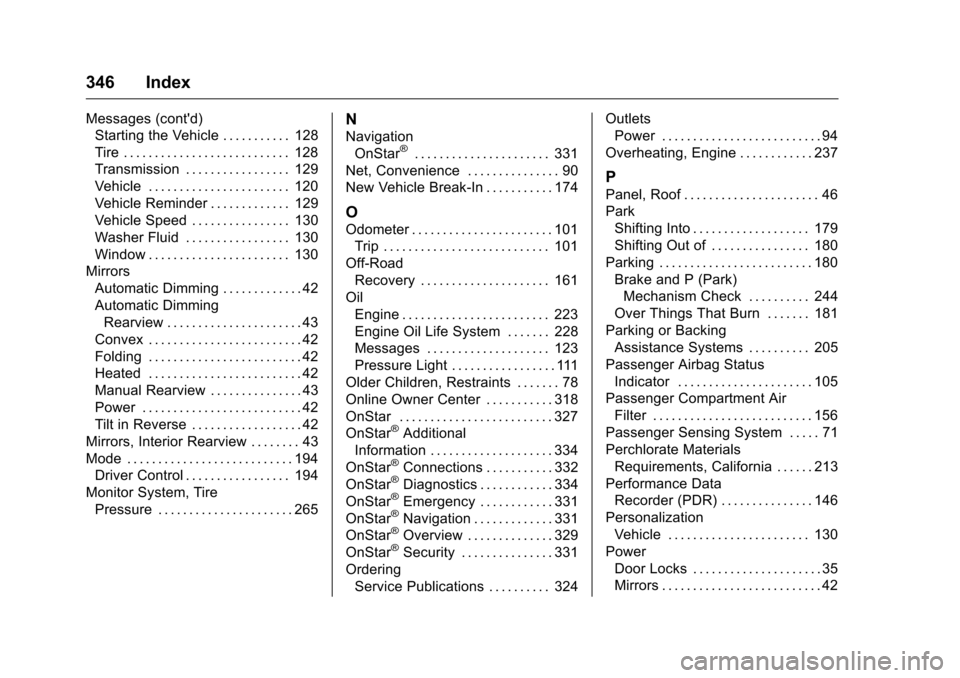
Chevrolet Corvette Owner Manual (GMNA-Localizing-U.S./Canada/Mexico-
9085364) - 2016 - crc - 9/15/15
346 Index
Messages (cont'd)Starting the Vehicle . . . . . . . . . . . 128
Tire . . . . . . . . . . . . . . . . . . . . . . . . . . . 128
Transmission . . . . . . . . . . . . . . . . . 129
Vehicle . . . . . . . . . . . . . . . . . . . . . . . 120
Vehicle Reminder . . . . . . . . . . . . . 129
Vehicle Speed . . . . . . . . . . . . . . . . 130
Washer Fluid . . . . . . . . . . . . . . . . . 130
Window . . . . . . . . . . . . . . . . . . . . . . . 130
Mirrors Automatic Dimming . . . . . . . . . . . . . 42
Automatic DimmingRearview . . . . . . . . . . . . . . . . . . . . . . 43
Convex . . . . . . . . . . . . . . . . . . . . . . . . . 42
Folding . . . . . . . . . . . . . . . . . . . . . . . . . 42
Heated . . . . . . . . . . . . . . . . . . . . . . . . . 42
Manual Rearview . . . . . . . . . . . . . . . 43
Power . . . . . . . . . . . . . . . . . . . . . . . . . . 42
Tilt in Reverse . . . . . . . . . . . . . . . . . . 42
Mirrors, Interior Rearview . . . . . . . . 43
Mode . . . . . . . . . . . . . . . . . . . . . . . . . . . 194 Driver Control . . . . . . . . . . . . . . . . . 194
Monitor System, Tire
Pressure . . . . . . . . . . . . . . . . . . . . . . 265N
NavigationOnStar®. . . . . . . . . . . . . . . . . . . . . . 331
Net, Convenience . . . . . . . . . . . . . . . 90
New Vehicle Break-In . . . . . . . . . . . 174
O
Odometer . . . . . . . . . . . . . . . . . . . . . . . 101 Trip . . . . . . . . . . . . . . . . . . . . . . . . . . . 101
Off-Road Recovery . . . . . . . . . . . . . . . . . . . . . 161
Oil Engine . . . . . . . . . . . . . . . . . . . . . . . . 223
Engine Oil Life System . . . . . . . 228
Messages . . . . . . . . . . . . . . . . . . . . 123
Pressure Light . . . . . . . . . . . . . . . . . 111
Older Children, Restraints . . . . . . . 78
Online Owner Center . . . . . . . . . . . 318
OnStar . . . . . . . . . . . . . . . . . . . . . . . . . 327
OnStar
®Additional
Information . . . . . . . . . . . . . . . . . . . . 334
OnStar
®Connections . . . . . . . . . . . 332
OnStar®Diagnostics . . . . . . . . . . . . 334
OnStar®Emergency . . . . . . . . . . . . 331
OnStar®Navigation . . . . . . . . . . . . . 331
OnStar®Overview . . . . . . . . . . . . . . 329
OnStar®Security . . . . . . . . . . . . . . . 331
Ordering Service Publications . . . . . . . . . . 324 Outlets
Power . . . . . . . . . . . . . . . . . . . . . . . . . . 94
Overheating, Engine . . . . . . . . . . . . 237
P
Panel, Roof . . . . . . . . . . . . . . . . . . . . . . 46
Park Shifting Into . . . . . . . . . . . . . . . . . . . 179
Shifting Out of . . . . . . . . . . . . . . . . 180
Parking . . . . . . . . . . . . . . . . . . . . . . . . . 180 Brake and P (Park)Mechanism Check . . . . . . . . . . 244
Over Things That Burn . . . . . . . 181
Parking or Backing Assistance Systems . . . . . . . . . . 205
Passenger Airbag Status Indicator . . . . . . . . . . . . . . . . . . . . . . 105
Passenger Compartment Air Filter . . . . . . . . . . . . . . . . . . . . . . . . . . 156
Passenger Sensing System . . . . . 71
Perchlorate Materials Requirements, California . . . . . . 213
Performance Data Recorder (PDR) . . . . . . . . . . . . . . . 146
Personalization Vehicle . . . . . . . . . . . . . . . . . . . . . . . 130
Power Door Locks . . . . . . . . . . . . . . . . . . . . . 35
Mirrors . . . . . . . . . . . . . . . . . . . . . . . . . . 42